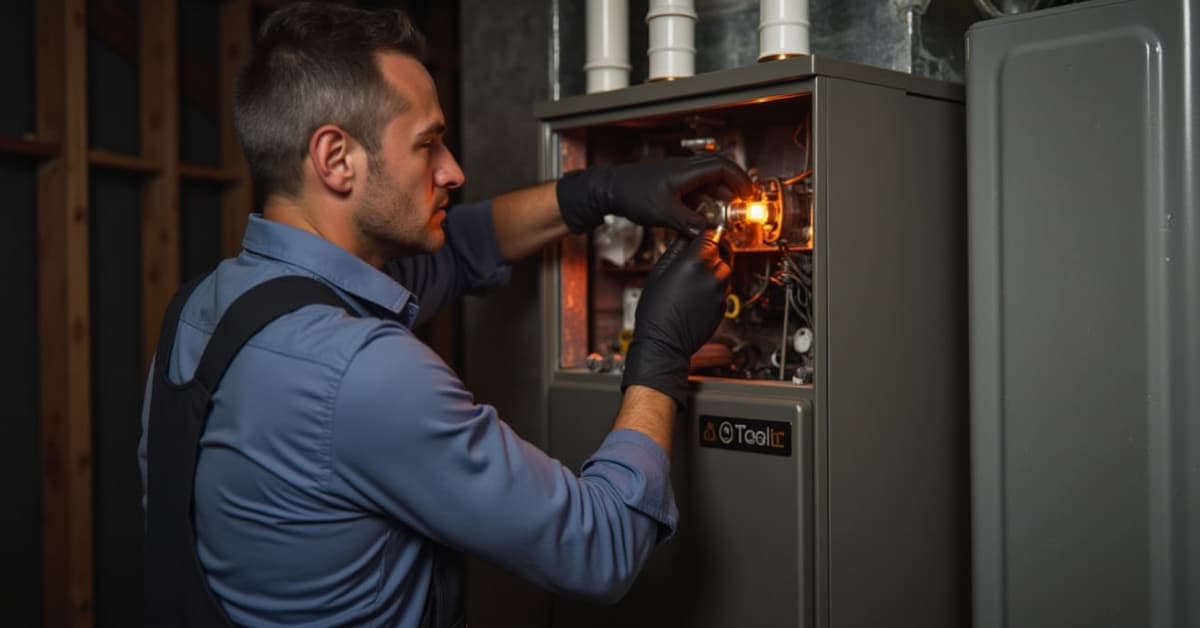February 14, 2025
Category: Blogs,
No one wants to experience that sinking feeling when they realize their furnace isn’t kicking on—especially when it’s freezing outside.
A cold house can be more than just uncomfortable; it can be a real problem. Not to mention, a faulty furnace can even make you sick. One common culprit behind a furnace that won’t heat is a problem with the ignition. If your electric or gas furnace is not lighting, it can feel like a major crisis, but often, the fix is simpler than you think.
This blog post will walk you through some easy-to-understand steps to diagnose the issue and hopefully get your furnace burning bright again. We’ll cover some common causes and troubleshooting tips so you can try to tackle the problem yourself before resorting to an expensive emergency call.
1. Check the Thermostat
Common Issue: Sometimes, the problem is as simple as an incorrect thermostat setting.
How to Fix: Make sure the thermostat is set to “heat” and the temperature is set higher than the current room temperature. Also, ensure the thermostat has fresh batteries if it runs on them.
Still feeling chilly? Read Our Ultimate Heating Guide to keep you warm all winter!
2. Pilot Light is Out (Older Furnaces)
Common Issue: Older furnaces may have a pilot light that can go out.
How to Fix: Locate the pilot light and follow the manufacturer’s instructions to relight it. If it continues to go out, there could be a draft or an issue with the thermocouple, which may need professional attention. If your furnace is not igniting due to a pilot light issue, this is the first place to check.
3. Ignition System Issues (Modern Furnaces)
Common Issues: Modern furnaces have electronic ignition systems that can malfunction. This could include a defective igniter, a faulty flame sensor, or problems with the control board. A common symptom is the gas furnace igniter not working.
How to Fix: Reset the ignition system by turning off the power to the furnace, waiting a few minutes, and turning it back on. If the furnace blower comes on but won’t ignite, the igniter might be the problem. A continuous flame that goes out after a few minutes could point to a flame sensor issue. If resetting doesn’t work, or you’re unsure about identifying components, it’s best to call a professional.
Having trouble turning off your furnace? Read our guide here.
4. Clogged Air Filters
Common Issue: Dirty or clogged air filters can restrict airflow, preventing the furnace from operating correctly. This can also lead to overheating.
How to Fix: Check and replace the air filters regularly. Ideally, this should be done every 1-3 months, depending on the type of filter and usage.
5. Gas Supply Issues
Common Issue: The furnace may not be receiving enough gas to light up. This could be due to a closed gas valve, a kink in the gas line, or a problem with the gas supply itself.
How to Fix: Ensure the gas valve to the furnace is fully open. If you’re comfortable doing so, check other gas appliances to see if they’re functioning properly. If not, there may be an issue with your gas supply line, and you’ll need to contact your gas company. If you smell gas, leave your home immediately and call 911.
6. Faulty Flame Sensor
Common Issue: A dirty or faulty flame sensor can prevent the furnace from staying lit. The flame sensor’s job is to detect the flame and ensure the gas valve stays open. If it’s dirty, it may not detect the flame, causing the furnace to shut off as a safety precaution.
How to Fix: Turn off the furnace and clean the flame sensor gently with a fine sandpaper or emery cloth. It’s a small, rod-like component usually located near the burner. If cleaning doesn’t help, the sensor may need to be replaced by a professional.
7. Tripped Circuit Breaker
Common Issue: The furnace’s circuit breaker may have tripped, cutting power to the unit.
How to Fix: Locate your home’s electrical panel and check if the furnace’s breaker has tripped. If it has, switch it back to the “on” position. If the breaker continues to trip, there may be a larger electrical issue that needs professional attention.
8. Dirty Gas Burners
Common Issue: Dirt builds up on your HVAC system’s burners, preventing them from burning evenly and at the proper height. This can lead to inefficient heating and potentially carbon monoxide buildup. If the furnace not igniting burners is your problem, this could be the cause.
How to Fix: You can spot-clean them by carefully blowing compressed air through each one and wiping the outside with a brush or cloth. Make sure the gas is turned off before doing this. It’s also helpful to dust your home regularly to prevent debris from getting into your furnace.
9. Draft Issues
Common Issue: If there is a strong draft in your basement or attic, or if there is a strong wind, the pilot light (older furnaces) may not light, or the flames may be blown out. A faulty or malfunctioning draft motor (newer furnaces) can also cause ignition problems.
How to Fix: Check for obstructions around the furnace and ensure proper ventilation. If the draft motor seems to be the problem, it’s best to call a professional.
When to Call a Professional
While some furnace issues can be resolved with a bit of troubleshooting, others require professional expertise. For example, if you’re dealing with a persistent issue like your furnace not lighting, it’s time to call a licensed HVAC technician like One Hour Heating and Air Conditioning to ensure your safety and the proper functioning of your furnace.

